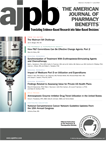Publication
Article
AJPB® Translating Evidence-Based Research Into Value-Based Decisions®
How P&T Committees Can Be Effective Change Agents: Part 2
Author(s):
Understanding the factors necessary for successful change management will make this work more satisfying and rewarding for P&T committees.
In the April 2010 issue of The American Journal of Pharmacy Benefi ts, I discussed the reality we face in our work on pharmacy & therapeutics (P&T) committees: change has become a part of modern formulary management and care delivery, and successfully leading change is a necessary and core skill of a P&T committee’s work.1 P&T committees must change in response to new therapies and technologies. They must change in response to a changing membership structure, which may result in a different set of skills and personal experiences. They must change to be more effective.
Pharmacy & therapeutics committees continually adjust and refi ne how they incorporate evidence-based decision making into formulary development and implementation. They drive implementation of formulary changes and medication use management initiatives. Their decisions can result in changes in clinical prescribing and practice as well.
In a landmark article published in 1995, Harvard Business School Professor John Kotter reviewed the factors necessary for a successful transformation effort.2 Professor Kotter offers reasons why the transformation process may fail. I instead focus on the reverse, on the ingredients for a successful P&T process and transformation effort.
In the first article I discussed some principles that Professor Kotter identifi es as essential for change: creating a sense of urgency, building a guiding coalition, and establishing and communicating the vision and direction. In this second article, I focus on 4 additional elements necessary for a successful transformation effort and apply them to the P&T committee process.
Removing Obstacles to the New Vision or Direction
Essential to effective change management is the ability to articulate either how a formulary change creates value for patients or how the change creates savings that can be reinvested to improve patient care. The most powerful vision formulary leaders can communicate is that of a safe and high-quality formulary that improves patient outcomes and avoids harm, in addition to making healthcare more affordable.
However, changes in formulary or medication use management typically require changes in behavior. Such changes will inevitably be opposed by some. Recognizing that change may be opposed is the fi rst step in removing potential “derailers” to successful transformation. For example, implementing a switch from one drug to another within a therapeutic class may be opposed by some on the grounds of convenience or safety as proxies for quality. Committees should respond early to potential arguments against the switch. Including those arguments in communications to patients, physicians, or purchasers also can help align those groups in the change process.
Systematically Planning for and Creating Short-Term Wins
One of the most effective ways to remove obstacles is to appropriately plan for and celebrate wins. In the case of medication use management, initiatives could be in place to identify early adopters or prescribers of a new drug within a therapeutic class. Publicizing their success by sharing their prescribing data is very effective in ensuring broad acceptance of the change. In working teams who are resistant to change, celebrating high-performing groups can help lower-performing teams see that the outcome is possible and could be motivating. An explicit commitment to plan for and create early wins—and then communicate and celebrate the success—can build ongoing momentum in the transformation efforts outlined by Professor Kotter.
Not Declaring Victory too Soon
Pharmacy & therapeutics committee members must continuously focus on the vision of creating value for patients and purchasers. A brighter future with safer, more effective medication use is a necessary component of the transformational work we do. Implementing this vision requires ongoing attention, and the work is never finished. The formulary always can be made safer, additional medication use management opportunities always can be identified, and information regarding current or new pharmaceuticals always will come to P&T committees. Declaring victory can lessen the meaning of the work for those doing it and allow those opposed to ongoing formulary or medication use improvement to declare the work is over—we are finished!
Anchoring Changes in the Corporate Culture
Pharmacy & therapeutics committees can anchor change in their cultures and the larger medical community by continuing to publicize formulary success and recruiting committee members who are committed to the ideals and vision of the work. Physician and pharmacy committee members who believe that “this is the way we do business” are the strongest members in your guiding coalition and your most important communicators. They also carry on the traditions of the effective P&T culture, and train and orient new committee members. When the everyday work that the committee does is linked with improved outcomes—whether in safety, quality, or affordability—the work is successful. Continuing to tell the story of past and current P&T success is an effective way to build the P&T culture so that it outlasts any single committee member.
Conclusion
The work that P&T committees do in formulary and medication use management is in many ways about leading change. We need to respond to new information about medication effectiveness and safety, and change formularies in response to that information. Factors known to promote and sustain change include removing obstacles, planning for and publicizing successes, understanding that the work is never fi nished, and anchoring transformation efforts in the corporate culture







